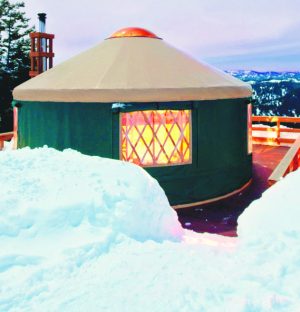April 28, 2006 – At 9:30 p.m. on Wednesday night, Canadian adventurer Richard Weber and his colleague became the first to snowshoe to the North Pole.
No skis, no dry suits for crossing open water, only snowshoes on an often harrowing, frequently surprising 880-kilometre journey, accompanied by British explorer Conrad Dickinson.
The two men struggled through hundreds of kilometres of ice rubble and day after day of almost zero visibility on the 52-day, 12-hour trek during which Mr. Weber fell through the ice and UV rays left both men with badly swollen faces.
Mr. Weber even contrived to burrow through a blizzard to find his wife, Josee Auclair, who was leading an expedition in the opposite direction.
She and the couple’s 17-year-old son, Tessum, were in a tent, sheltering from a blizzard. It was a far cry from the family’s home in the Gatineau Hills near Wakefield.
With their adventure complete, a Russian helicopter dropped down to airlift the successful explorers to Borneo, a temporary camp set up on drifting ice at approximately 89 degrees. From there they were to be flown to Spitzbergen, Norway.
They had to abandon plans to be picked up by a light plane and flown to Canada because the threat of continuing blizzard conditions could have made it impossible to land and warming conditions would not allow any delay.
It was a small inconvenience at the end of a remarkable adventure for Mr. Weber, 46, and Mr. Dickinson, 50.
“The Old Guys have done it!” they reported in their final e-mail home. “Our bodies are very tired but we are both very satisfied and pleased with our efforts. We have also enjoyed each other’s company.”
The men were in transit yesterday, but the e-mail messages they sent home during their trek offers glimpses into a remarkable journey.
The friendship that was to be so rigorously tested had begun on the afternoon of March 4 when they landed at Ward Hunt Island, the most northerly land in Canada.
They carried their food and equipment to a hut once occupied some years previously by Ranulph Fiennes, another Arctic adventurer. Mr. Fiennes had been forced to abandon his attempt to be the first to reach the Pole alone and unassisted after falling into the icy Arctic Ocean. He had been flown to Ottawa for treatment for frostbite, but later lost fingers.
It was -40C the following morning as Mr. Weber and Mr. Dickinson donned snowshoes and dragged one sled 10 kilometres through very difficult pack ice before returning to the hut. It had taken 10 hours and was an early sign of tough times ahead. The following day, they dragged the second sled to where they had left the first.
The next morning, the battle was really joined as the two men took seven hours to weave their way through less than three kilometres of chunks of ice as large as a metre square. They had little time to admire the fantastic orange skies.
March 9 continued to be slow going and the explorers suffered other minor setbacks. Mr. Dickinson’s camera stopped working, his inflatable mattress sprung a leak, making for “chilly sleeping,” and he split a sled from end to end on the rough ice and had to wire it back together.
Ice conditions began to smooth out in the next few days and by March 23, they were achieving 14 kilometres a day.
They maintained that pace in the following days, although they were often slowed by stretches of open water they had to walk round, make snow bridges for or hop from one ice chunk to the next.
On March 29, Mr. Weber wrote that to reach the Pole by pickup deadline — April 27 — they would have to cover 18.5 kilometres a day for the next 31 days.
The April 2 message offered unusual insight into what must be endured during such an expedition.
“A clear sign that we are working hard is that we are each consuming 7,000 calories a day and still tightening our waist bands a notch or two,” Mr. Dickinson wrote. “Our diet consists of pasta and pemmican. The pemmican is a mixture of suet, ground meat and wheat grain, based on an ancient Antarctic recipe for sled dogs! Our pemmican mix was made more palatable by a French chef.”
He also revealed that the men craved their daily intake of 125 grams of pure butter, eaten alone, and their “evening cocktail of hot milk and maple sugar is a well looked-forward-to treat.” He added that the daily tots of whisky would run out the next day. Not something to raise a glass to.
By April 9, near-whiteout conditions for six days and soft snow had been making it tough to keep up the pace, although they were over halfway there, with less than 370 kilometres to go.
In this message, Mr. Dickinson passed on a disquieting observation from Mr. Weber: “In over 20 years experience of the Arctic Ocean, Richard has never seen such bad conditions. Could this be global warming with May conditions in April?”
By April 13, the men were talking about travelling for 11 hours at night to maintain their schedule after being forced to take cover in their tent during a 24-hour blizzard. Their faces had started to swell from a combination of sun, wind and cold, and they had to improvise and make face masks out of spare material to protect themselves.
There had been no mention of the day Mr. Weber fell through the ice until April 17.
“We have no skis and only snowshoes that, although fantastic in rough ice, are not as good as skis when trying to cross thin ice,” Mr. Dickinson wrote that day.
“We confirmed their shortcomings when Richard fell completely through thin ice two weeks ago at -33 centigrade. As dry snow acts like blotting paper, Richard rolled in the snow and Conrad shovelled it over him to get rid of as much water as possible.
“To maintain our daily mileage, Richard made the brave decision to continue travelling for four hours, which was tough going as his clothes were like a suit of armour and his boots like diving boots encased in ice.”
By April 21, the two men were talking about a race against time to reach the Pole before the April 27 new moon, which creates high tides that crack open ice. “All we do is eat, sleep and travel,” Mr. Weber wrote. “We are working to a 26-hour clock to squeeze more travel into each day.”
April 24 was an extraordinary day for Mr. Weber. There was just 50 kilometres to go and three days to do it in when, as Mr. Dickinson relates, a “truly new and unusual condition” happened.
“Richard’s wife, Josee, is leading a supported trip from the North Pole to Canada and, with modern satellite communications and GPS, we were able to cross paths and exchange stories. It was a very special occasion for Richard, meeting Josee and his son, Tessum, who was also on the expedition. It was surreal to come upon their tent in a blizzard!”
Two days later, another great Arctic adventure was over.
Mr. Weber has led or participated in more than 45 Arctic expeditions and operates Arctic Watch, Canada’s most northerly adventure resort, on Somerset Island in the Northwest Passage.
In 1995, he and Russian Misha Malakhov skied unsupported to the North Pole and back, the only time that feat has ever been accomplished. At the time, it was described as the “greatest feat in Polar history.”
His latest success may challenge that claim.
Top News Stories
Richard Weber Completes Another Arctic Trek
provided by the cccLeave a Reply
You must be logged in to post a comment.






![National camp action [P]...](https://skitrax.com/wp-content/uploads/2019/08/Duluth-4-2019-08-08-at-10.46.51-AM-300x246.png)
![Matt Liebsch on the CXC Elite Team [P] CXC...](https://skitrax.com/wp-content/uploads/2019/08/Matt-Liebsch-CXC.2-525x700.4-300x267.jpg)
![Dan LaBlanc [P]...](https://skitrax.com/wp-content/uploads/2019/08/Dan-LaBlanc-img_1855.3.jpg)
